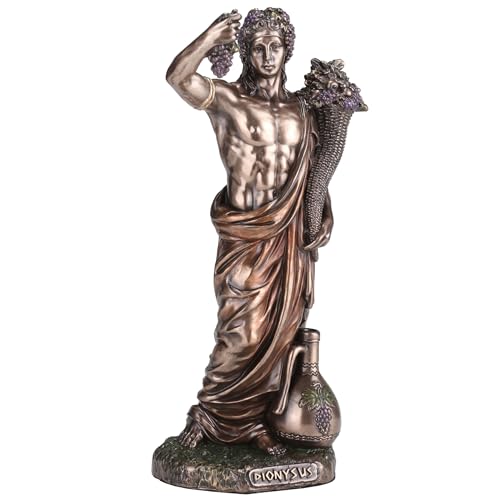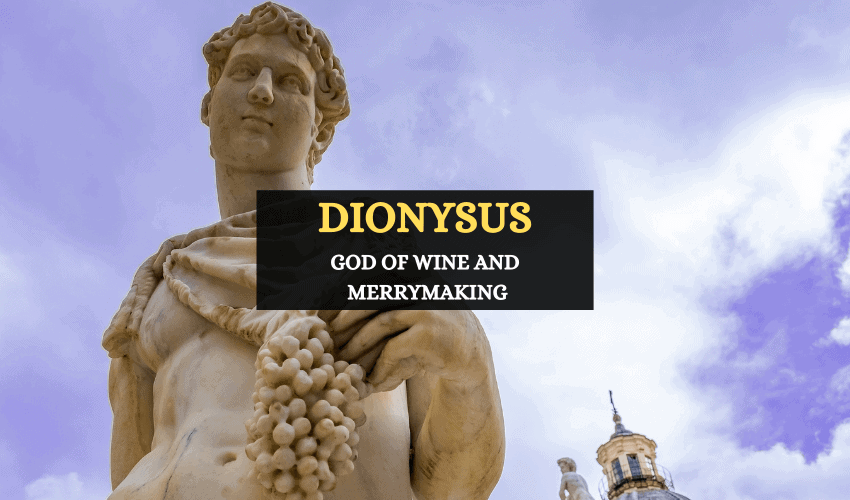
Table of Contents
Dionysus (Roman equivalent Bacchus) is the god of wine, grape-harvest, ritual madness, theater and fertility in Greek mythology, known for giving humans the gift of wine and for his fantastic festivals and celebrations. The god was famous for his cheerful energy and madness. Here’s a closer look at Dionysus.
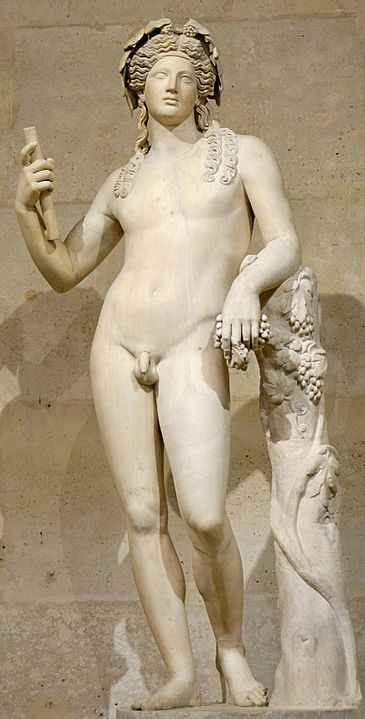
Origins of Dionysus
The myth of Dionysus had its roots not in ancient Greece but farther to the east. There are several instances where Dionysus takes trips to Asia and India, which could justify the suggestion that he originated elsewhere.
In Greek mythology, Dionysus was the son of Zeus, the god of thunder, and Semele, the daughter of King Cadmus of Thebes. Zeus impregnated Semele in the form of a mist so the princess never actually saw him.
Dionysus was the god not only of wine and fertility but also of theater, madness, festivity, pleasure, vegetation, and wild frenzy. He’s often depicted as a god with duality – one the one hand, he symbolizes merrymaking, joy and religious ecstasy, but on the other hand, he would demonstrate brutality and wrath. These two sides reflect the duality of wine as both a positive and a negative item.
Dionysus – The Twice-Born
When Dionysus was conceived, Hera was mad with jealousy at the infidelity of Zeus and plotted to take revenge. She appeared to the princess in disguise and told her to ask Zeus to show her his godly form. Semele requested this from Zeus, who, before knowing what the princess wanted, had made an oath to deliver any request.
The almighty Zeus appeared in front of Semele, but the power of his full form was too much for her mortal body to see. Semele couldn’t handle this glorious image and burned to death, but Zeus was able to take the fetus out of her body. Zeus attached Dionysus to his thigh until the baby’s development was complete, and he was ready to be born. Thus, Dionysus is also known as the Twice-Born.
Early Life of Dionysus
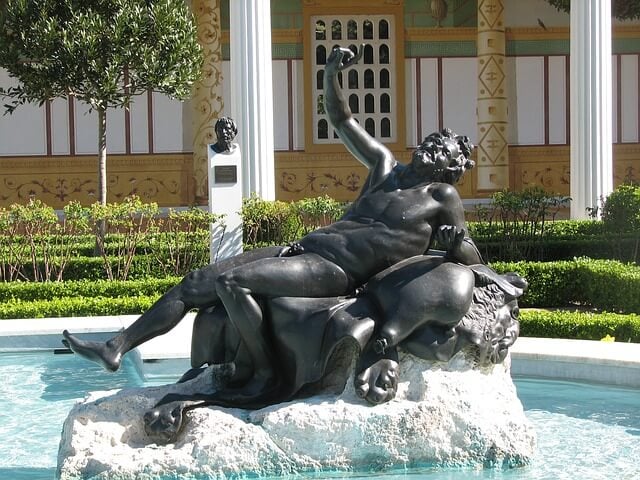
Dionysus was born a demigod, but his development attached to Zeus’ thigh gave him immortality. To protect him from Hera’s anger, Zeus commanded the satyr Silenus to take care of the demi-god on Mount Etna.
After being looked after by Silenus, the god was handed over to his aunt Ino, Semele’s sister. When Hera discovered the location of Dionysus, she cursed Ino and her husband with madness, causing them to kill themselves and their kids.
There are depictions of Hermes taking care of the child-god too. He appears in several of the early stories of Dionysus. Some myths also say that Hera gave Dionysus to the titans as a child for them to kill. After this, Zeus resurrected his son and attacked the titans.
Below is a list of the editor’s top picks featuring Dionysus’s statue.
Myths Related to Dionysus
Once Dionysus had grown up, Hera cursed him to wander around the country. And so, Dionysus traveled Greece spreading his cult.
The celebrations to Dionysus were orgiastic festivals in which the god’s frenzied madness possessed the people. They danced, drank, and lived beyond their existence during these festivities. It was believed that the theater came out of these festivals, which called Dionysia or Bacchanalia. Dionysus roamed the land, accompanied by the Bacchae, who were a group of women, nymphs, and satyrs.
During this time, he was involved in many stories and myths. Due to his upbringing on earth, there are several myths of the god in which kings and common people disrespected his role as a god or did not honor him as such.
- King Lycurgus
King Lycurgus of Thrace attacked Dionysus and the Bacchae while they were crossing the land. Some other sources say that the attack of the Thracian king was not on the god, but against the excess of his festivals. Either way, the god of wine cursed the king with madness and blindness.
- King Pentheus
After the episode in Thrace, Dionysus arrived in Thebes, where King Pentheus called him a false god and refused to let the women join the festivities that he had announced. After that, the King tried to spy on the women who were about to join the god. For this, the Bacchae (his cult) ripped apart King Pentheus in a rush of Dionysus’ frenzied madness.
- Dionysus and Ariadne
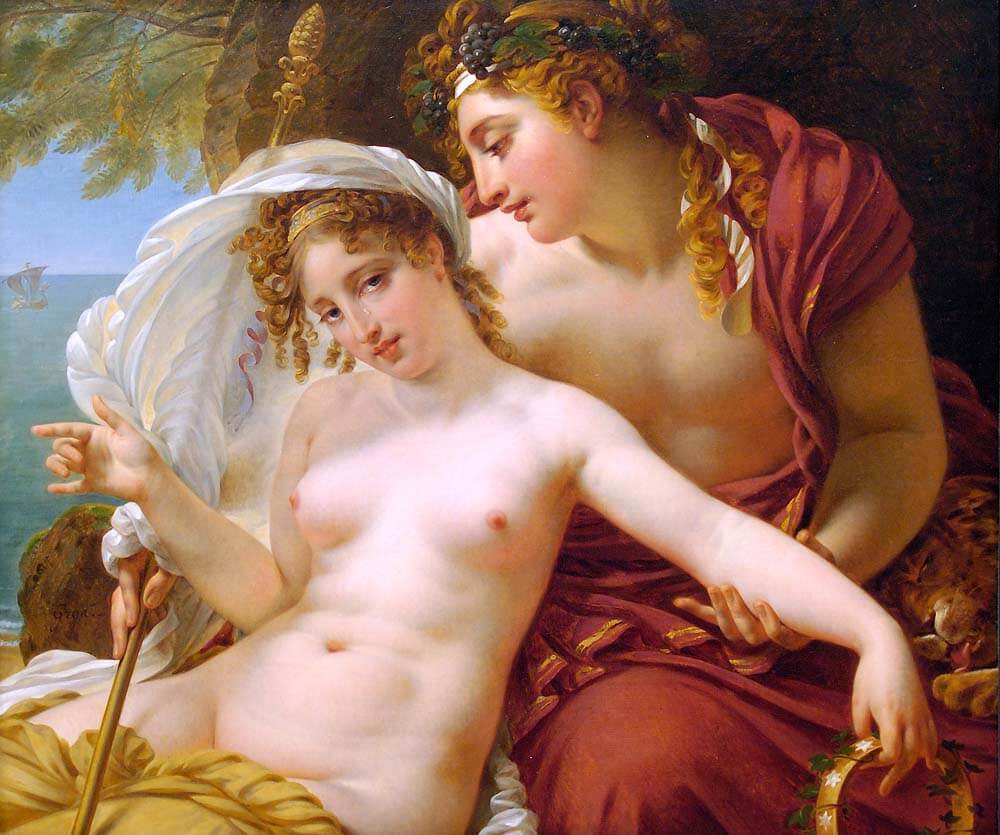
On one of his journeys, The Tyrrhenian pirates captured Dionysus and thought to sell him to slavery. Once they had sailed, the god turned the mast of the ship into a great vine and filled the ship with wild creatures. The pirates jumped off the board, and Dionysus transformed them into dolphins upon reaching the water. Dionysus continued to sail to Naxos, where he would find Ariadne, the daughter of King Minos of Crete, who had been abandoned there by her beloved Theseus, the hero who had killed the Minotaur. Dionysus fell in love with her and married her.
It’s interesting that while the festivals of Dionysus were full of worldly pleasures and he himself was represented by a phallus, he remains loyal to Ariadne who is his only consort.
- King Midas and the Golden Touch
One of Dionysus’ most known stories is his encounter with King Midas, the king of Phyrgia. In return for a favor he had once done for him, Dionysus gave King Midas the ability to turn everything he touched into gold. This gift, however, would wind up being a less glamorous ability than expected since the king could neither eat nor drink and was pushed to the brink of death because of his ‘gift’. Dionysus then took this golden touch away at the request of the king.
This story has become one of the most popular in modern culture, with the phrase Midas touch used to refer to the ability to make money out of anything you undertake.
- Dionysus and Winemaking
Dionysus taught the art of winemaking to the Athenian hero Icarius. After learning it, Icarius shared the drink with a group of shepherds. Unaware of the effects of the alcoholic drink, the men thought that Icarius had poisoned them and they turned on him and killed him. Thanks to Dionysus and his cult, wine would become one of Greece’s most popular drinks.
- Dionysus and Hera
Some myths propose that Dionysus gained the favor of Hera after fetching Hephaestus and taking him to the heavens to free Hera from her throne. Dionysus got Hephaestus drunk and was able to deliver him to Hera so that she could be free.
- Dionysus’ Journey to the Underworld
After some time roaming Greece, Dionysus worried about his dead mother and traveled to the underworld to look for her. The god of wine found his mother and took her with him to Mount Olympus, where Zeus transformed her into the goddess Thyone.
Symbols of Dionysus
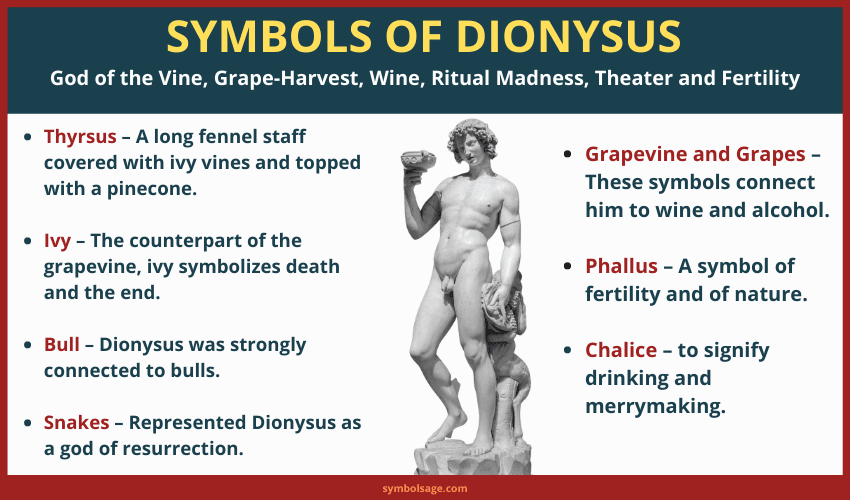
Dionysus is often depicted along with his many symbols. These include:
- Grapevine and grapes – Dionysus is often shown with grapes and vines around his head or in his hands. His hair is sometimes depicted as being fashioned from grapes. These symbols connect him to wine and alcohol.
- Phallus – As a god of fertility and of nature, the phallus symbolizes procreation. The Dionysian cult would often carry a phallus in their processions to bless the lands with fertility and bountiful harvests.
- Chalice – signifying drinking and merrymaking
- Thyrsus – also called a thyrsos, this is typically a long fennel staff covered with ivy vines and topped off with a pinecone.
- Ivy – ivy is the counterpart of the grapevine, representing his duality. While the grapevine signifies life, merrymaking and living, ivy symbolizes death and the end.
- Bull – the god was sometimes depicted with bull horns and was strongly connected to bulls.
- Snakes – Dionysus was a god of resurrection, and snakes have been associated with resurrection and regeneration. They’re can also be seen as symbols of lust, sex and the phallus.
Dionysus himself was initially depicted as a bearded, elderly man. However, later he began to be seen as a young, almost androgynous man.
Influence of Dionysus
Dionysus was normally associated with lust, madness, and orgies. Dionysus also had to do with the centaurs for their uncontrollable drinking and sex lust.
Since he introduced wine to the world, he became an influential god in daily life in ancient Greece. The big parties and the great stories with drunken characters normally evoked the god of wine.
The beginning of the theater in Greece had its roots in the Dionysiac festivals. A variety of retrieved plays from ancient Greece were exclusively written for these celebrations.
Dionysus Facts
Dionysus is the god of the vine, wine, merrymaking, fertility, religious ecstasy and theater.
Dionysus’ parents are Zeus and the mortal Semele.
Dionysus had many children including Hymen, Priapus, Thoas, Staphylus, Oenopion, Comus and the Graces.
Dionysus’ consort is Ariadne, whom he met and fell in love with on Naxos.
Dionysus is depicted as a god of agriculture and associated with vegetation. He’s associated with several natural objects such as grapes, orchards and the harvesting of grapes. This makes him a nature god.
Dionysus’ Roman equivalent is Bacchus.
In Brief
Unlike the other gods, Dionysus traveled around Greece performing feats and making people join his cult with his actions. His influence in the daily life and the arts of ancient Greece still impacts today’s culture. The god of wine remains a remarkable figure in Greek Mythology.





